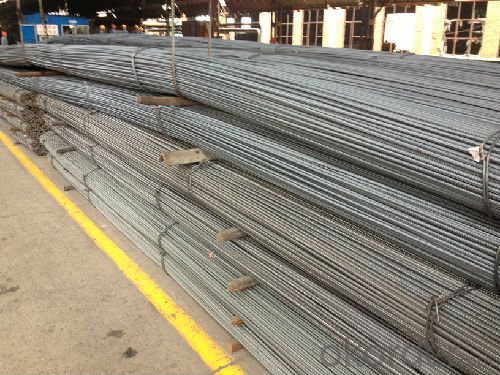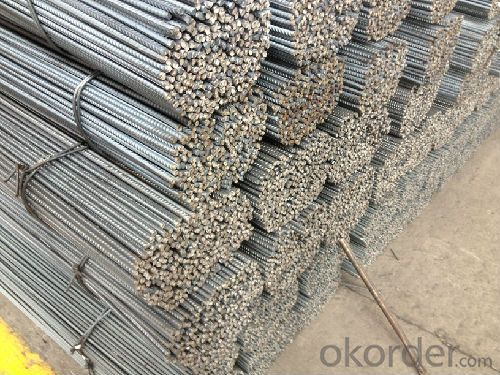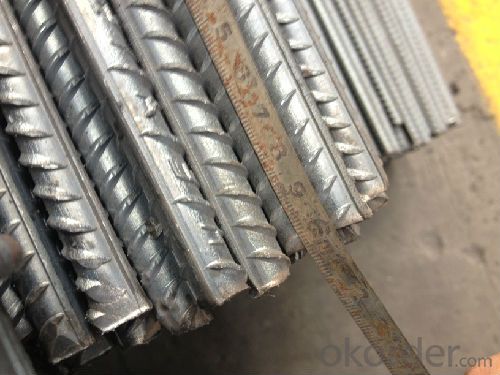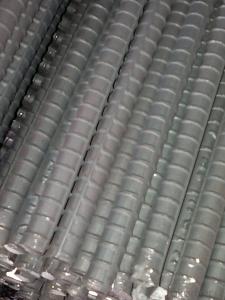Hot Rolled Steel Deformed steel bar rebar High Qulity
- Loading Port:
- Tianjin
- Payment Terms:
- TT or LC
- Min Order Qty:
- 1000 m.t.
- Supply Capability:
- 3500 m.t./month
OKorder Service Pledge
OKorder Financial Service
You Might Also Like
Product Description:
OKorder is offering Hot Rolled Steel Deformed steel bar rebar High Qulity at great prices with worldwide shipping. Our supplier is a world-class manufacturer of steel, with our products utilized the world over. OKorder annually supplies products to European, North American and Asian markets. We provide quotations within 24 hours of receiving an inquiry and guarantee competitive prices.
Product Applications:
Hot Rolled Steel Deformed steel bar rebar High Qulity In China are ideal for structural applications and are widely used in the construction of buildings and bridges, and the manufacturing, petrochemical, and transportation industries.
Product Advantages:
OKorder's Hot Rolled Steel Deformed steel bar rebar High Qulity are durable, strong, and resist corrosion.
Main Product Features:
· Premium quality
· Prompt delivery & seaworthy packing (30 days after receiving deposit)
· Corrosion resistance
· Can be recycled and reused
· Mill test certification
· Professional Service
· Competitive pricing
Product Specifications:
Standard | GB | HRB400 | |
Diameter | 6mm,8mm,10mm,12mm,14mm,16mm,18mm,20mm, 22mm,25mm,28mm,32mm,36mm,40mm,50mm | ||
Length | 6M, 9M,12M or as required | ||
Place of origin | Hebei, China mainland | ||
Advantages | exact size, regular package, chemical and mechanical properties are stable. | ||
Type | Hot rolled deformed steel bar | ||
Brand name | DRAGON | ||
Packaging & Delivery of Hot Rolled d-bar Steel
1. Packing: it is nude packed in bundles by steel wire rod
2. Bundle weight: not more than 3.5MT for bulk vessel; less than 3 MT for container load
3. Marks:
Color marking: There will be color marking on both end of the bundle for the cargo delivered by bulk vessel. That makes it easily to distinguish at the destination port.
Tag mark: there will be tag mark tied up on the bundles. The information usually including supplier logo and name, product name, made in China, shipping marks and other information request by the customer.
If loading by container the marking is not needed, but we will prepare it as customer request.
4. Transportation: the goods are delivered by truck from mill to loading port, the maximum quantity can be loaded is around 40MTs by each truck. If the order quantity cannot reach the full truck loaded, the transportation cost per ton will be little higher than full load.
5. Delivered by container or bulk vessel
FAQ:
Q1: Why buy Materials & Equipment from OKorder.com?
A1: All products offered byOKorder.com are carefully selected from China's most reliable manufacturing enterprises. Through its ISO certifications, OKorder.com adheres to the highest standards and a commitment to supply chain safety and customer satisfaction.
Q2: How do we guarantee the quality of our products?
A2: We have established an advanced quality management system which conducts strict quality tests at every step, from raw materials to the final product. At the same time, we provide extensive follow-up service assurances as required.
Q3: How soon can we receive the product after purchase?
A3: Within three days of placing an order, we will begin production. The specific shipping date is dependent upon international and government factors, but is typically 7 to 10 workdays.
Q4: What makes stainless steel stainless?
A4: Stainless steel must contain at least 10.5 % chromium. It is this element that reacts with the oxygen in the air to form a complex chrome-oxide surface layer that is invisible but strong enough to prevent further oxygen from "staining" (rusting) the surface. Higher levels of chromium and the addition of other alloying elements such as nickel and molybdenum enhance this surface layer and improve the corrosion resistance of the stainless material.
Q5: Can stainless steel rust?
A5: Stainless does not "rust" as you think of regular steel rusting with a red oxide on the surface that flakes off. If you see red rust it is probably due to some iron particles that have contaminated the surface of the stainless steel and it is these iron particles that are rusting. Look at the source of the rusting and see if you can remove it from the surface.
Images:



- Q:How do steel rebars contribute to the overall safety of a structure?
- Steel rebars contribute to the overall safety of a structure by providing reinforcement and strength to concrete. They enhance the structural integrity, preventing cracking and failure under heavy loads or during seismic events. Steel rebars also help to distribute and absorb forces, improving the resistance against bending, shearing, and tension. By effectively reinforcing the concrete, steel rebars ensure the durability and longevity of the structure, minimizing the risk of collapse and ensuring the safety of occupants.
- Q:What are the different types of couplers used for connecting steel rebars?
- There are several types of couplers used for connecting steel rebars, including mechanical couplers, lap splices, and grouted splices. Mechanical couplers are typically threaded or tapered and provide a mechanical connection between the rebars. Lap splices involve overlapping the rebars and securing them with tie wires or welding. Grouted splices involve placing the rebars in a sleeve or coupling filled with grout to create a bonded connection.
- Q:Can steel rebars be painted or coated?
- Yes, steel rebars can be painted or coated. Painting or coating steel rebars helps to protect them from corrosion and extend their lifespan. It is a common practice in construction and reinforcement projects to apply paint or protective coatings on steel rebars to enhance their durability and resistance to environmental factors.
- Q:Can steel rebars be used in sustainable construction practices?
- Yes, steel rebars can be used in sustainable construction practices. Steel is a highly durable material that can be recycled, reducing the need for new production and minimizing environmental impact. Additionally, steel rebars provide strength and structural integrity to constructions, allowing for longer lifespan and reduced maintenance requirements. By incorporating steel rebars in sustainable construction practices, we can promote resource efficiency and minimize the overall environmental footprint.
- Q:How do steel rebars improve the durability of concrete structures?
- Concrete structures can be made more durable in various ways through the use of steel rebars. Firstly, steel rebars act as reinforcement, adding strength and stability to the structure. When combined with concrete, the high tensile strength of steel rebars helps resist cracking and prevent collapse under heavy loads or seismic activities. Secondly, steel rebars assist in controlling the formation and spread of cracks in concrete structures. Concrete is strong in compression but weak in tension, making it prone to cracking under tensile forces. By strategically placing steel rebars within the concrete, cracks are minimized and prevented from spreading, thereby improving the overall durability of the structure. Furthermore, steel rebars enhance the resistance of concrete structures against corrosion. The highly alkaline nature of concrete forms a protective layer around the steel rebars, preventing rust. This corrosion resistance ensures the rebars maintain their structural integrity over time, reducing the risk of deterioration and enhancing the longevity of the concrete structure. Moreover, steel rebars also increase the fire resistance of concrete structures. With their high melting point, steel rebars can withstand high temperatures, preventing the concrete from losing its structural integrity during a fire. This additional fire resistance ensures the stability and safety of the concrete structure in case of a fire, further enhancing its durability. In conclusion, the inclusion of steel rebars significantly enhances the durability of concrete structures by providing added strength, controlling cracks, improving corrosion resistance, and increasing fire resistance. These advantages contribute to the longevity and safety of concrete structures, making them more reliable and sustainable in the long term.
- Q:How are steel rebars cut and shaped on-site?
- On-site, steel rebars are commonly subjected to cutting and shaping using a variety of tools and techniques. The typical process entails the following steps: 1. Measurement: Prior to anything else, the rebars are measured to determine their required length and shape. Measuring tapes, rulers, or other measuring devices are employed for this purpose. 2. Marking: Once the measurements have been taken, the rebars are marked at the appropriate points using chalk or a marker. These markings serve as guidelines to ensure accurate cutting and shaping of the rebars. 3. Cutting: Mechanical or hydraulic cutting tools are then utilized to cut the rebars along the marked lines. Rebar cutters, angle grinders with cutting discs, or portable band saws are some commonly employed tools. These tools are specifically designed to handle the high strength of steel rebars, resulting in clean and precise cuts. 4. Shaping: After the rebars have been cut to the desired lengths, they can be further shaped as required. This shaping process involves bending the rebars to specific angles or curves. Manual rebar benders or electric rebar bending machines are commonly used for this purpose. These tools enable accurate shaping of the rebars, ensuring compliance with the necessary structural design. 5. Tying: Once the rebars have been cut and shaped, they are often bound together using wire or rebar tying machines. This binding process aids in securing the rebars in their designated positions within the concrete structure. It is important to emphasize that the cutting and shaping of rebars on-site necessitate skilled workers who possess the necessary training to handle the tools and observe appropriate safety measures. These workers must also possess a solid understanding of the structural requirements and be capable of interpreting construction drawings to accurately cut and shape the rebars in accordance with the project specifications.
- Q:What is the lifespan of steel rebars in a concrete structure?
- The lifespan of steel rebars in a concrete structure can vary depending on various factors such as the quality of the steel, the level of exposure to environmental conditions, and the maintenance practices. However, generally speaking, steel rebars in a well-constructed and properly maintained concrete structure can last for several decades or even more than a century.
- Q:Can steel rebars be used in road and bridge construction?
- Yes, steel rebars can be used in road and bridge construction. Steel rebars are commonly used as reinforcement in concrete structures, including roads and bridges, to provide strength and durability. The rebars are embedded within the concrete to enhance its tensile strength and prevent cracking or structural failure. Steel rebars are preferred in such constructions due to their high strength, ductility, and resistance to corrosion. They help to distribute loads and stresses evenly, making the structures more resilient and capable of withstanding heavy traffic and environmental conditions. Additionally, steel rebars can be easily fabricated and customized to meet the specific design requirements of road and bridge construction projects.
- Q:How do steel rebars affect the structural integrity of a building?
- Steel rebars play a crucial role in enhancing the structural integrity of a building. They are used to reinforce concrete structures by providing extra strength and resistance to various forces, such as tension, compression, and bending. The inclusion of steel rebars helps to distribute loads more evenly, prevent cracks, and increase the overall durability and stability of the building.
- Q:Can steel rebars be used in parking structure construction?
- Using steel rebars in parking structure construction is a common practice. They provide strength and durability to reinforced concrete structures. The use of steel rebars is especially important in parking structures due to the heavy loads and traffic they experience. These rebars are typically placed in the concrete slabs, walls, and columns of the structure, improving its load-bearing capacity and resistance to compression, tension, and bending. Additionally, steel rebars can also reinforce ramps, driveways, and other areas that require extra support. Overall, incorporating steel rebars is crucial in parking structure construction to comply with safety standards and ensure the facility's longevity.
1. Manufacturer Overview |
|
|---|---|
| Location | |
| Year Established | |
| Annual Output Value | |
| Main Markets | |
| Company Certifications | |
2. Manufacturer Certificates |
|
|---|---|
| a) Certification Name | |
| Range | |
| Reference | |
| Validity Period | |
3. Manufacturer Capability |
|
|---|---|
| a)Trade Capacity | |
| Nearest Port | |
| Export Percentage | |
| No.of Employees in Trade Department | |
| Language Spoken: | |
| b)Factory Information | |
| Factory Size: | |
| No. of Production Lines | |
| Contract Manufacturing | |
| Product Price Range | |
Send your message to us
Hot Rolled Steel Deformed steel bar rebar High Qulity
- Loading Port:
- Tianjin
- Payment Terms:
- TT or LC
- Min Order Qty:
- 1000 m.t.
- Supply Capability:
- 3500 m.t./month
OKorder Service Pledge
OKorder Financial Service
Similar products
New products
Hot products
Related keywords





























